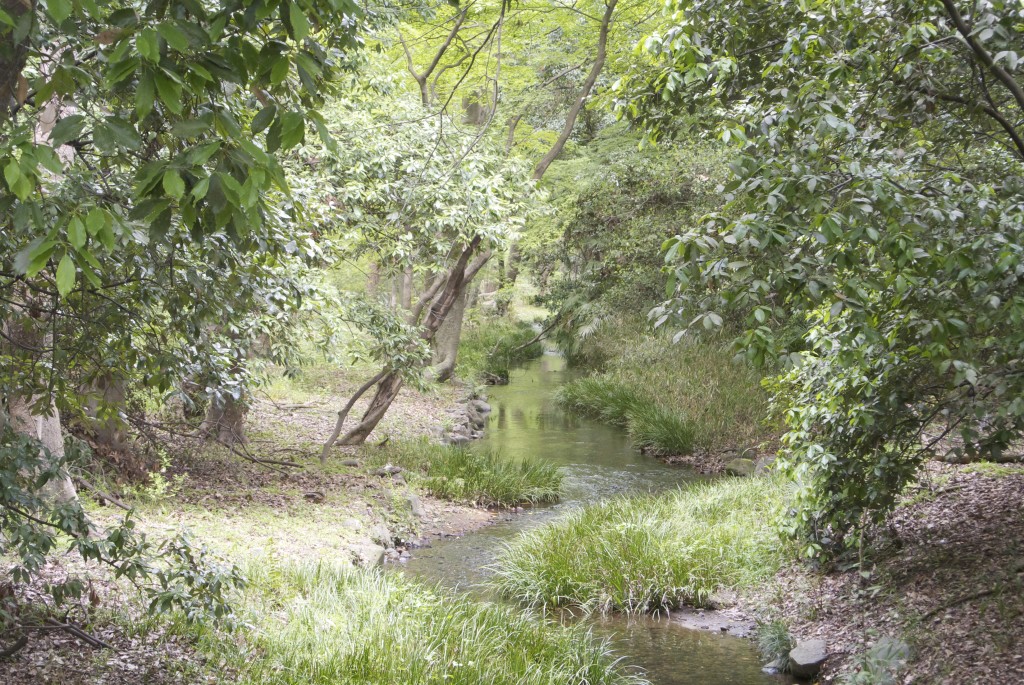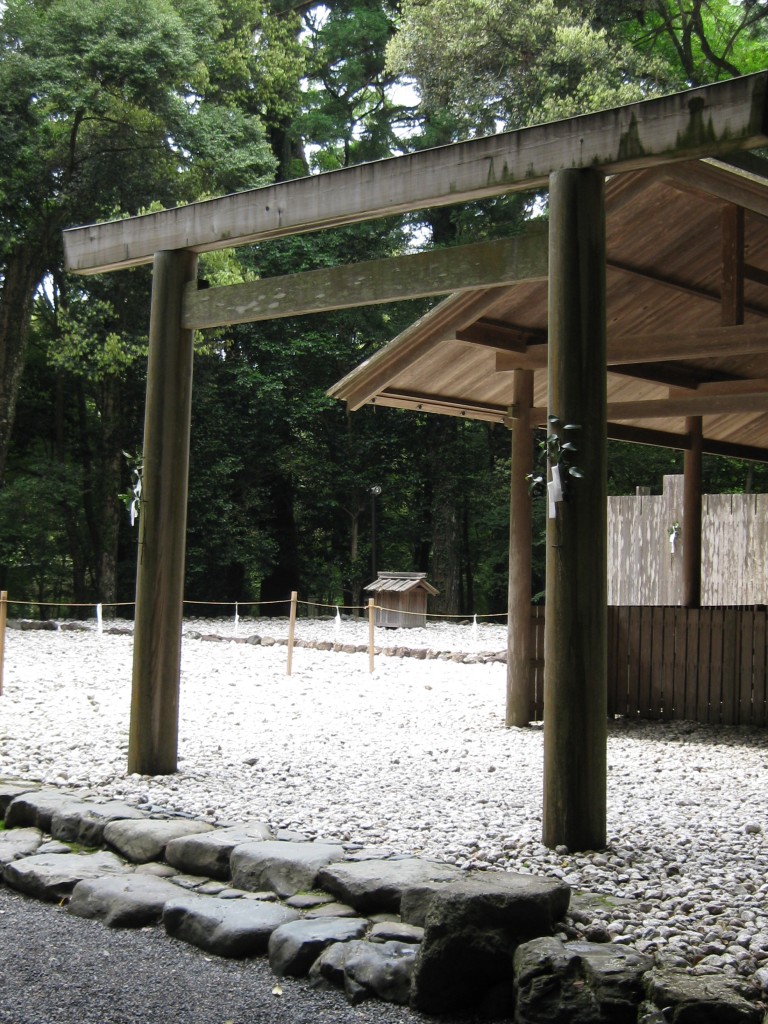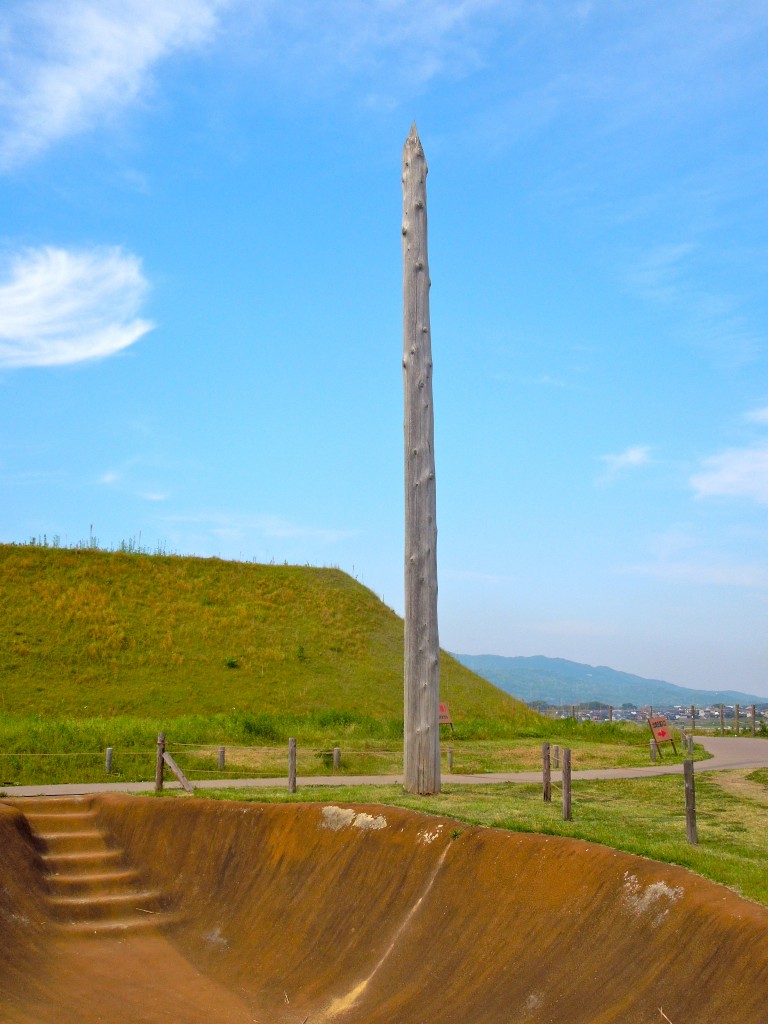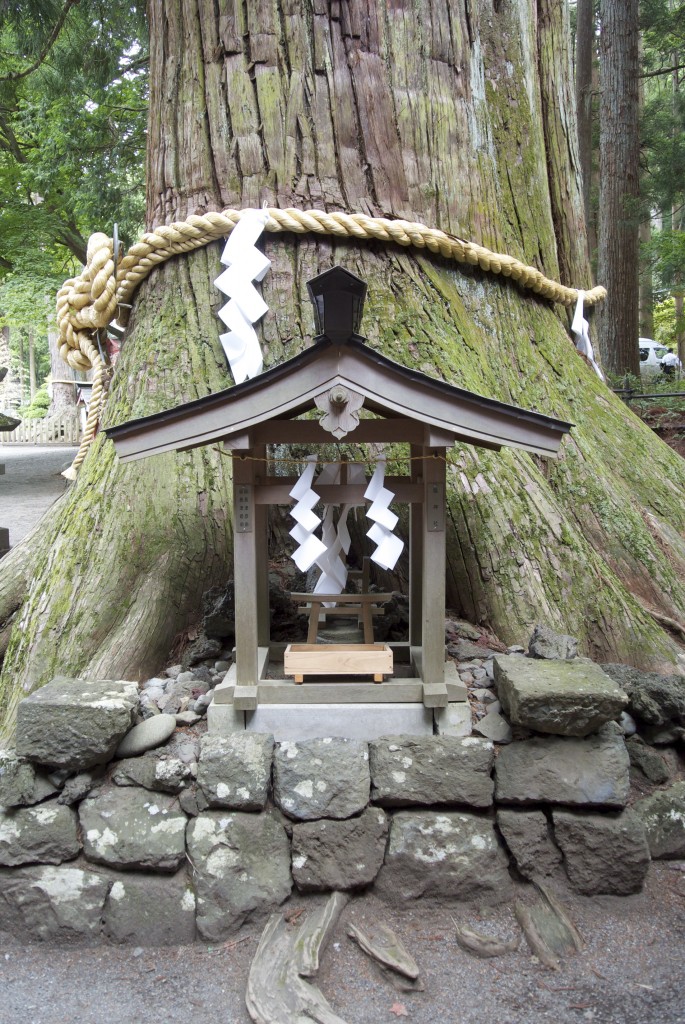
This is the second part of a prize-winning essay by Mike Zdan, entered for the International Shinto Studies Association competition in 2011. For the first part, please click here.
*******************************************************************
When the historic ginkgo at Tsurugaoka Hachimangu was uprooted due to a storm in 2010, people across Japan – as well as those who had visited the shrine from other countries – expressed a common sense of loss and sadness. However, these feelings turned to relief and excitement at news that new shoots had grown from the trunk, and that the tree’s life was beginning again.

One of the many shrines at Ise to be renewed every 20 years. Next to it is an open space for the rebuilding, with a small structure covering the shin-no-mihashira (sacred central pillar)
A theme of natural cycles, continuation, and renewal begins to take place in this way. Perhaps the most symbolic of the mutual relationship of shrines and trees is seen in the shikinen sengu ceremony at the Grand Shrine of Ise, during which the shrine complex is taken down and rebuilt anew, every twenty years. For over a thousand years, this ceremony has continued, with shrine buildings rebuilt of local timber on adjacent sites, and festivals held to commemorate the transfer of the enshrined kami to the new building.
Crossing the Isuzu River, passing through torii into the grounds of the shrine, one enters a deepening forest of cedar. As the sounds of traffic grow faint, the iconic buildings of the shrine come into view. The simple and elegant style of construction pairs the unfinished timber and its gold accents with the rich greens and reds of the surrounding cedars, and is unique to the Grand Shrine.
Enshrined at this important location is the kami of the sun, Amaterasu Omikami. The ceremonies of thanksgiving conducted at Ise recognize that all living things receive energy from this same, ultimate source. In this grove, the lives of man and tree are recognized as springing from a common origin. Though doctrines, ideals, and concepts of various faiths and philosophies differ, the understanding of the source of life’s energy represented here is fundamental.
A tree at Ise grows upwards to the sun from the soil, composed itself in part from trees that had formed the shrine ages ago. Similarly, the busy festival of rebuilding ensures the transmission of the skills, ideas and understanding of one generation to the next. For twenty years then, what remains in the space left beside the renewed shrine, marked by contrasting black and white pebbles? Only a small building, sheltering the tip of a wide cedar pillar, anchored deep into the earth. This is the shin-no-mihashira (sacred central pillar); the yorishiro at the heart of the shrine.

Spirit pillar as used in Yayoi times for shamanic rites
The architect Tange Kenzo recognized that the erection of a single post in the center of a sacred area strewn with stones represents the form taken by Japanese places of worship in very ancient times; the shin-no-mihashira would thus be the survival of a symbolism from a very primitive symbolism to the present day. Like the forest mountain yorishiro of Omiwa Jinja, the pillar at Ise illustrates the impressive intuition of people long ago concerning the natural world, and helps us understand a concept vital to Shinto.
Sustained and surrounded by old growth forest, the relationship between the Grand Shrine and its trees allows it to be at once ancient, and at the same time young and vibrant, able to look to the future.
More than simply a vehicle to teach the techniques of building the shrine, the dedication to this form for over a thousand years suggests a purpose and mind to preserve something important. That those who care for the shrine strive to ensure that a tree remains at its heart is extremely significant. By using a great tree in this way, they compel us to respect it, and the natural world that it represents.
The late Reverend Yukitaka Yamamoto outlined the Shinto concept of interconnectedness as kannagara, the way of living harmoniously with other people, the physical world, and kami. He illustrated that we exist at a crossroads, connected vertically from kami and our forefathers through to those who will come after, and on a horizontal plane to people throughout the world. Like trees sprouting upwards from the earth, our roots as humans and living beings share a common origin, and our actions in life shape the world that our children will inherit. We are not isolated; we interact with the world, its ecosystems, its society and its people, like the branches of a tree growing and extending outwards. At once simple and profound, Shinto’s awareness of the interconnectedness of all things is invaluable.
As a truly global civilization, our focus on mutual relationships has broadened. More and more, we communicate and work across boundaries of nation and language. Moving from studies of the symbiosis of two species, to the connections between seasonal cycles of distant ecosystems, we continue to reevaluate our position relative to the environment we live in. Advances in both communication and in scientific understanding continue to broaden our point of view.
This is not to say that our existence is free from challenges and difficulty. It is not an easy task to empathize with those with whom we disagree. Also, as we find that the economic and environmental systems that we interact with are extremely complex and interrelated, we may feel overwhelmed with crises we are unable to anticipate.
Yet, we are recognizing more and more that the desire to live in harmony with the natural world and those with whom we share it will not only ensure our survival, but enable us to thrive, mutually benefiting each other in turn. Sharing a common origin as living beings, we have the potential to realize this way of life.
From the use and symbolism of trees in shrine ritual, to their illumination of the concept of kami, this relationship clearly demonstrates many facets of Shinto itself. Yet, if the connection of Shinto shrines to trees can also illustrate to the modern mind “the deep spiritual intuition of the universality of creative divinity,” we will have learned a powerful concept indeed.

Shrine to the spirit of the tree, an example of “the deep spiritual intuition of the universality of creative divinity”

Leave a Reply